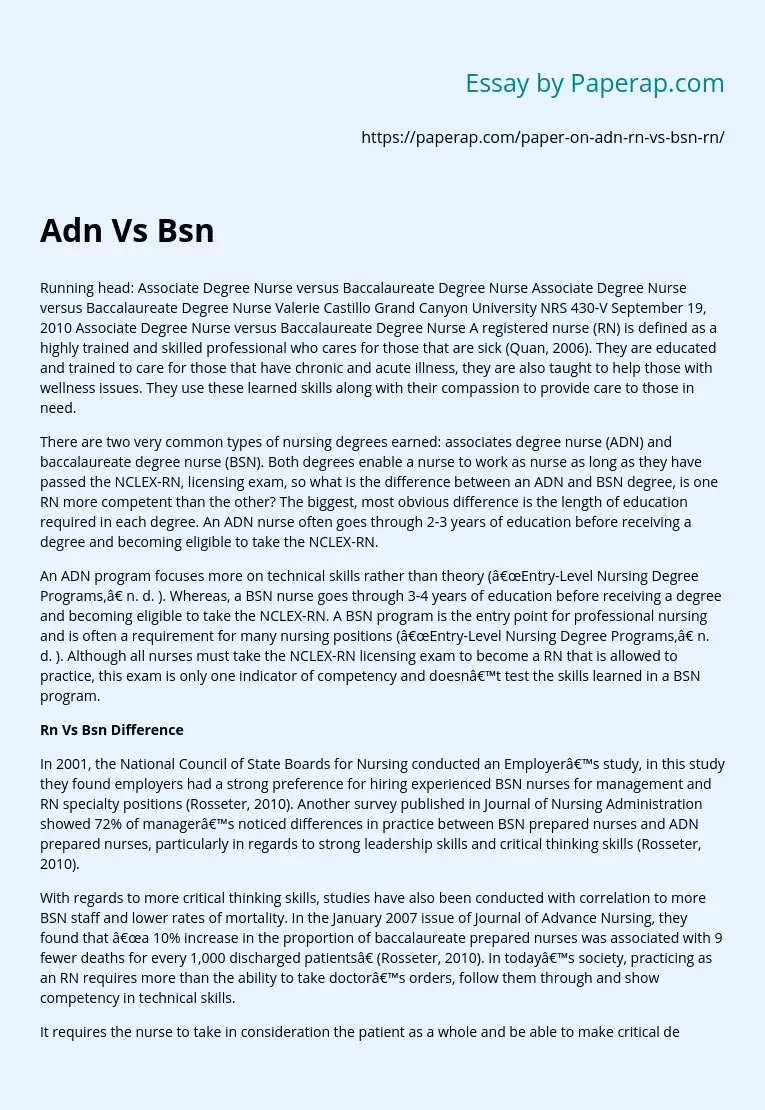Rn Vs Bsn Difference
Running head: Associate Degree Nurse versus Baccalaureate Degree Nurse Associate Degree Nurse versus Baccalaureate Degree Nurse Valerie Castillo Grand Canyon University NRS 430-V September 19, 2010 Associate Degree Nurse versus Baccalaureate Degree Nurse A registered nurse (RN) is defined as a highly trained and skilled professional who cares for those that are sick (Quan, 2006). They are educated and trained to care for those that have chronic and acute illness, they are also taught to help those with wellness issues. They use these learned skills along with their compassion to provide care to those in need.
There are two very common types of nursing degrees earned: associates degree nurse (ADN) and baccalaureate degree nurse (BSN). Both degrees enable a nurse to work as nurse as long as they have passed the NCLEX-RN, licensing exam, so what is the difference between an ADN and BSN degree, is one RN more competent than the other? The biggest, most obvious difference is the length of education required in each degree.
An ADN nurse often goes through 2-3 years of education before receiving a degree and becoming eligible to take the NCLEX-RN.
An ADN program focuses more on technical skills rather than theory (“Entry-Level Nursing Degree Programs,” n. d. ). Whereas, a BSN nurse goes through 3-4 years of education before receiving a degree and becoming eligible to take the NCLEX-RN. A BSN program is the entry point for professional nursing and is often a requirement for many nursing positions (“Entry-Level Nursing Degree Programs,” n. d. ). Although all nurses must take the NCLEX-RN licensing exam to become a RN that is allowed to practice, this exam is only one indicator of competency and doesn’t test the skills learned in a BSN program.
In 2001, the National Council of State Boards for Nursing conducted an Employer’s study, in this study they found employers had a strong preference for hiring experienced BSN nurses for management and RN specialty positions (Rosseter, 2010). Another survey published in Journal of Nursing Administration showed 72% of manager’s noticed differences in practice between BSN prepared nurses and ADN prepared nurses, particularly in regards to strong leadership skills and critical thinking skills (Rosseter, 2010).
With regards to more critical thinking skills, studies have also been conducted with correlation to more BSN staff and lower rates of mortality. In the January 2007 issue of Journal of Advance Nursing, they found that “a 10% increase in the proportion of baccalaureate prepared nurses was associated with 9 fewer deaths for every 1,000 discharged patients” (Rosseter, 2010). In today’s society, practicing as an RN requires more than the ability to take doctor’s orders, follow them through and show competency in technical skills.
It requires the nurse to take in consideration the patient as a whole and be able to make critical decisions; it also means that the nurse should be able to question a doctor’s order when they seem inappropriate. An RN with a BSN has often had more liberal arts classes which enables them to have sharper critical thinking skills along with having been exposed to more cultures and different people (Forster, n. d). An example, a 70-year old female patient was admitted on Tuesday for a skull fracture as a result of syncope. Initial cat scans showed a small subdural bleed in the left side of temporal and parietal lobes.
The patient has since then been in the ICU, now out of the ICU on a neurological floor. The patient’s assessment has been stable with no changes noted in the neurological assessment; however the patient continues to complain of a headache, increased lightheadedness and dizziness with ambulation along with nausea. The days come and go, with the intent of discharging the patient but exactly a week later, still hospitalized the patient complains of the worst headache of her life and extreme nausea despite being given every anti-nausea medication possible.
The doctors are made aware, a stat Cat Scan is performed, no change is noted to the bleed. The pain and nausea however are only worsening causing the patient to actually make herself through up. What next, disregard the patient’s pain and nausea as a result of the injury, so just continue to treat it or be the patient’s advocate and call the doctor insisting that something is still wrong? An ADN nurse, as she was educationally prepared to medicate patients as needed and based on their complaints, may disregard the headache and nausea and attribute it to a complication of this type of head injury.
With that said the ADN RN is most likely to keep trying to give the patient more pain and nausea medication, in hopes that with time this phase of the injury may pass. A BSN nurse would more likely do a little more critical thinking and give it a holistic approach such as looking at all patient care aspects. This RN would probably redo a complete head to toe assessment and thorough neurological assessment. She may also look into the patient’s labs, further investigate the headache and nausea such as precipitating and aggravating factors, when it occurs, what makes it better or worse if anything and then call the doctor if indicated.
All in all, both types of degrees enable a nurse to practice their job with competence however a BSN degree definitely opens up more opportunities and gives nurses the ability to give their patients the very best care possible. A BSN degree also prepares an RN to develop the critical thinking skills and communication skills that set a BSN nurse apart from an ADN nurse.
Rn Vs Bsn Difference. (2019, Dec 05). Retrieved from https://paperap.com/paper-on-adn-rn-vs-bsn-rn/

